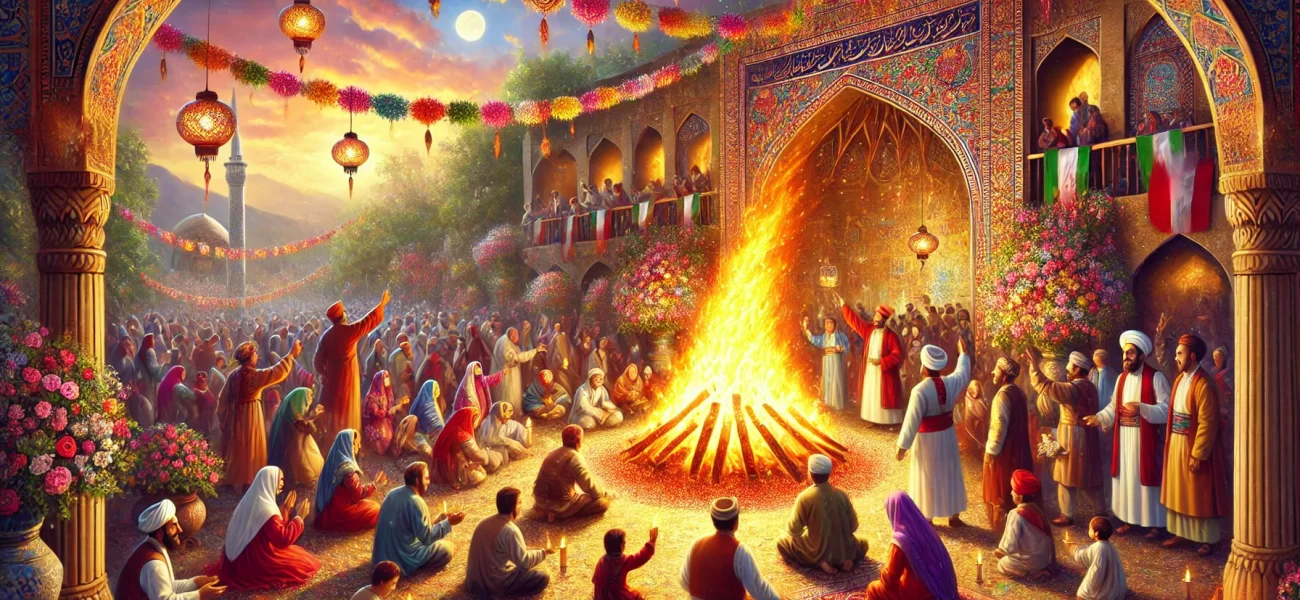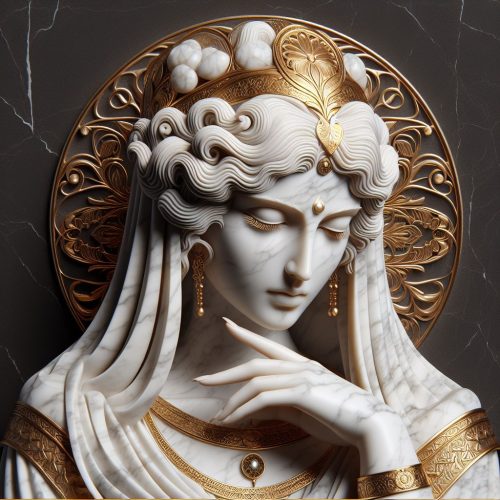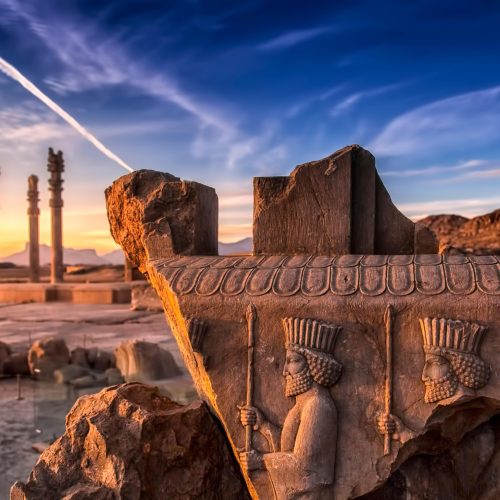“The fire kindled in the hearth of an ancient temple, the whispers of a past that has shaped the soul of our people, and the justice enshrined in the pillars of tradition—these are the echoes of Shahrivargān, a festival that once burned brightly in the hearts of the Iranians.”
A Timeless Festival Born of Fire
In the rolling hills of ancient Iran, beneath the vaults of a sky steeped in the hues of saffron and violet, there once burned a sacred fire. It was not just any fire, for this was a flame born of divine will—a symbol of order, righteousness, and protection. This fire was the essence of Shahrivargān, a festival forgotten by time but essential to the very heart of Zoroastrian belief. Shahrivargān, celebrated on the 4th day of the month of Shahrivar in the ancient Zoroastrian calendar, is dedicated to Shahrivar Amshaspand (Amesha Spenta), the divinity of dominion, strength, and most crucially, justice.
As we revisit this festival, we do more than dust off the relics of the past—we reconnect with the profound values that sustained an empire, the spiritual ideals that transcended the temporal, and the moral compass that once guided a civilization renowned for its magnanimity, wisdom, and sense of justice.
But Shahrivargān is not just a festival; it is a living testament to the Iranian spirit—one that still smolders in the soul of our nation, yearning to be reignited. This is not merely a story of ancient rites but a call to remember, to reclaim, and to reignite that flame of justice in the modern world.
Shahrivar Amshaspand: The Protector and Keeper of Justice
In the pantheon of Zoroastrianism, Shahrivar Amshaspand stands as one of the six Amesha Spentas, or “Bounteous Immortals,” divine entities who govern the various aspects of creation. Each Amesha Spenta is linked with both a material element and an ethical quality, embodying Ahura Mazda’s vision for an ordered world. Shahrivar Amshaspand governs metal and the strength of sovereignty, representing the force that maintains righteousness through power, dominion, and justice.
But more than these worldly domains, Shahrivar Amshaspand is also the protector of those who seek justice—an upholder of the oppressed, and a defender of those in need. In ancient Iran, a land carved by mountains and crowned by temples of eternal flame, the rule of law was not merely a human construct; it was divine. The festivals that celebrated the Amesha Spentas were not mere ritual; they were the living expression of cosmic order, a means of inviting the divine presence into the world of mortals.
Shahrivargān is the earthly reflection of this divine presence. It calls forth the power of Shahrivar Amshaspand to ensure that justice is upheld, that strength is wielded not for cruelty or oppression, but for the protection of the weak and the establishment of a just society. In ancient times, this day was marked by acts of charity, offerings of precious metals, and prayers for the king’s righteous rule. The Zoroastrians believed that through the celebration of Shahrivargān, they were participating in the ongoing battle against the forces of chaos, a battle in which justice and order would ultimately prevail.
The Sacred Flame: Fire as the Symbol of Justice and Purity
It is impossible to speak of Shahrivargān without invoking the sacred element of fire. Fire, to the Zoroastrians, was not merely a physical phenomenon; it was the purest symbol of truth, clarity, and divine presence. The fire that burned in the great temples of ancient Iran was tended with the utmost care, and it was believed that the flame held the essence of Ahura Mazda’s wisdom.
The fire of Shahrivargān burned in temples, but it also burned in the hearts of those who sought justice. The light of the flame was said to reveal the truth, illuminating the path for the righteous. To celebrate Shahrivargān was to stand before the fire and to reflect on one’s deeds—on whether one’s life had contributed to the justice and order of the world or whether one had added to the chaos and disorder that threatened it.
Throughout the Iranian plateau, in cities that gleamed like jewels in the desert sun and in villages that dotted the verdant valleys, people would gather around these fires. The festival was a time for communal reflection, a time to ask for forgiveness for past wrongs and to renew one’s commitment to the Zoroastrian ethical code, which was anchored in the principles of asha (truth) and rata (justice).
But Shahrivargān was also a celebration of hope. It affirmed the belief that, in the end, justice would prevail—that Shahrivar Amshaspand would stand victorious over the forces of druj (the lie). The fire was not merely a symbol of the present order; it was a promise of the future victory of righteousness.
The Golden Thread of Kingship and Justice
In ancient Persia, kingship was intertwined with divinity. The monarch was seen not only as a ruler but as the earthly representative of Ahura Mazda’s divine order. The Zoroastrian concept of kingship was not one of absolute power; rather, it was tempered by the idea that the king must rule with khvarenah, the divine glory bestowed upon him by the gods, and with arta, the principle of justice.
Shahrivargān, therefore, was not just a festival for the people—it was a royal celebration. The king would offer prayers to Shahrivar Amshaspand, asking for guidance to rule justly and wisely. Gifts of gold and silver were offered, symbolizing the strength and durability of the kingdom. But these offerings were not for personal enrichment; they were dedicated to the greater good, a symbol of the king’s commitment to the people and the moral order of the universe.
Justice, in this context, was not an abstract concept. It was the foundation upon which the Persian Empire thrived. The laws of Cyrus the Great, the administrative reforms of Darius, and the moral teachings of Zoroaster all contributed to a system that valued fairness, equity, and the protection of the vulnerable. In this system, Shahrivar Amshaspand played a central role, embodying the ideals that made the empire not only a political entity but also a beacon of ethical governance.
As we look back on this golden age, we are reminded that justice was not merely a policy but a sacred duty—a duty to both the divine and to one’s fellow man. Shahrivargān was a yearly reaffirmation of that duty, a time when the king and the people alike recommitted themselves to the pursuit of a just and ordered world.
Rituals of Shahrivargān: Celebrating the Power of Justice
The celebration of Shahrivargān was marked by a series of deeply symbolic rituals, each one imbued with the rich spiritual and ethical significance of the festival. While much of the ancient practices have been lost to time, historical accounts and Zoroastrian texts give us a glimpse into how this sacred day was observed.
The festival began at dawn, when the first rays of the sun would break over the mountains and kiss the temple spires, igniting the eternal flames within. Worshippers would gather at fire temples, bringing offerings of gold, silver, and precious metals—symbols of Shahrivar Amshaspand’s dominion over strength and rulership. These metals were not merely material gifts; they represented the purity of intent and the desire for justice that the people wished to manifest in the world.
Prayers were offered to Shahrivar Amshaspand, asking for strength to overcome adversity, wisdom to govern justly, and protection from the forces of druj. The recitation of these prayers, known as yashts, was a deeply communal act, one that united the people in their shared pursuit of a just and harmonious society.
Perhaps the most significant ritual of Shahrivargān was the rekindling of the sacred fire. In Zoroastrian belief, fire is the most sacred of elements, a direct link to the divine. By lighting new fires or rekindling existing ones, the people sought to renew their connection with Shahrivar Amshaspand and reaffirm their commitment to the principles of justice and righteousness.
In the evening, as the sun set and the stars emerged, the fires would burn brightly in the temples, a reminder that even in the darkness, justice would continue to shine. It was believed that the light of these flames would guide the spirits of the righteous and protect the kingdom from the forces of chaos that lurked in the shadows.
Shahrivargān in the Modern World: A Flame Rekindled?
Today, Shahrivargān is largely forgotten, a relic of an ancient past. Yet, as we stand at the crossroads of history, we must ask ourselves: is this a festival that should remain in the shadows of our collective memory, or is it a flame that deserves to be rekindled?
In a world that often seems dominated by injustice, where the weak are trampled and the powerful reign unchecked, the message of Shahrivargān is more relevant than ever. The ideals that this festival embodies—the pursuit of justice, the protection of the vulnerable, and the responsibility of rulers to govern with wisdom and fairness—are timeless. They speak to the very core of what it means to be human, to live in a society, and to strive for a better world.
As an Iranian scholar and historian, I believe that we must not let Shahrivargān fade into obscurity. This festival is a part of our heritage, a vital link to our past and a source of inspiration for our future. By reviving the celebration of Shahrivargān, we can reignite the flame of justice that once burned so brightly in the hearts of our ancestors.
We live in a time when justice is often elusive, when the forces of chaos seem to threaten the order of the world. But Shahrivargān reminds us that justice is not something that can be imposed from above—it must be cultivated within, through our actions, our choices, and our commitment to the greater good. The fire that burned in the temples of ancient Iran still burns within us, waiting to be rekindled.
As we look to the future, let us remember the lessons of Shahrivargān. Let us honor the legacy of Shahrivar Amshaspand, the protector of justice, by striving to create a world where fairness, compassion, and righteousness prevail. Let us reignite the flame of justice, so that it may burn brightly for generations to come.
The Eternal Flame of Justice
Shahrivargān is more than a festival—it is a reflection of our deepest values, a reminder of the ethical foundations upon which our civilization was built. It is a call to remember the sacred duty of justice, a duty that transcends time and place. Though the fires of Shahrivargān may no longer burn in our temples, they can still burn in our hearts.
In a world where injustice so often reigns, where the forces of chaos and oppression seem overwhelming, the message of Shahrivargān is one of hope. It is a reminder that justice is not merely an ideal—it is a flame that must be tended, nourished, and passed down from one generation to the next.
Let us, the descendants of an ancient and noble people, carry forward the legacy of Shahrivargān. Let us reignite the flame of justice, so that it may burn brightly once more, lighting the way toward a better and more just world.
Shahrivargān may belong to the past, but its flame can still guide our future.




